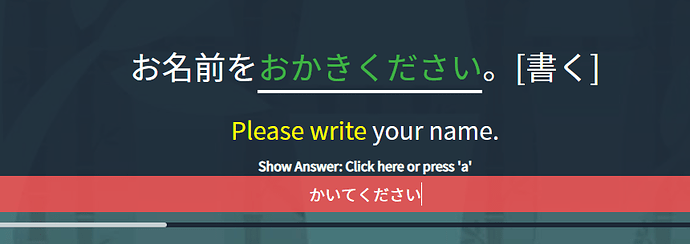Yes! Especially for cases where you’ve made a mistake unrelated to the current grammar point (e.g., getting the て-form wrong), but where you click “oops” and correct yourself as the main point was correct 
(… see also This :D)
お風呂に入ってから、ゆっくりし たり、本をよんだりしたい。[読む]
I had the English translation on still, so it was fine. But if I changed it to hide there’s no way I would have known to put it in たい form.
I’m reading through a story meant for first graders and discovered grammar missing from here. It’s ていない which essentially means “not doing” for example 雨は降っていない meaning “it’s not raining”. I’ve found grammar points for ている and ていた but not ていない. Thought I’d call it out to see if it could be added?
According to this site it should be N5
When I get an answer wrong and hit backspace, the orange hint pops up. Is this intentional?
If you understand ている and ない, what more is there to say with ていない?
I have replaced some ている examples, with examples that use negative form ていない (ていません).
I hope it helps 
Cheers!
Appreciate it. Since you had a separate grammar point for ていた I figured I’d see one for ていない.
IMO, ~ていない isn’t quite as straightforward as it might appear to be on the surface (although I still wouldn’t say that it’s difficult). By that I mean, 食べていない might be understood by us learners as “I am not eating,” which isn’t completely wrong, but it’s perhaps more accurate to translate it as “I haven’t eaten” (which, notably, also implies that I am currently not eating).
So, it functions similarly to English’s present perfect, if I’m not mistaken.
True, but the まだ~ていません grammar point covers that case.
I agree, I’ve heard a lot of ていない spoken on dramas and they are definitely mean “haven’t”
@Kai @jamie @seanblue @nathan.powers10
It can mean both, "not doing " or "has/have not done ".
It all depends on context, often the first meaning is used with 今,今や and second with から (昨日から何も食べていません), まだ (まだ何も食べていません) all kinds of even (さえ、も) 朝ごはんさえ食べていません
まだ is often omitted.
BY THE WAY, you guys probably noticed but with some words まだ can be used with words that are not in 「ていない」 form, but in simple negative form (できない、くれない). This only applies to handful of verbs, so be careful. Always try to use 「ていない」 version.
I had wondered about that, actually. Thanks!
Just came across this in DoBJG and was curious if Bunpro has this as an optional answer for ておく https://bunpro.jp/grammar_points/162 The とく・どく informal contractions? I don’t currently have ておく in my reviews so I can’t test for it, figured I’d bring it up just in case.
@conan We do! Any review question marked [casual] will also accept the とく・どく informal contractions.  Cheers!
Cheers!
Hi! I was wondering, is there any chance of adding an option under the “Review English” settings to hide the translation but display the full sentence at once when clicked? I prefer to read the sentence myself first, then check the translation if needed to see what goes in the blanks—but the Hide setting right now has you click through the partial translation first, which often makes the answer clear on its own even if I haven’t glanced at the sentence at all. It’s not a huge issue, but it’d be a nice quality of life feature to have.
Is it intentional that tapping the yellow text during reviews (when only that is visible) shows the whole sentence? That was very unexpected, considering there’s already a button to show the whole text.
The book we used in my Japanese class here in Japan is called できる日本語 (the first one so far, next term and “N4” will be the second one) and the first book more or less covers N5. It isn’t JLPT geared exactly, but that is what it basically covers. Except towards the later chapters it has some N4 grammar (according to BP), and interestingly some of those points are sprinkled in lessons 1-4 (or so) of N4, and then a whole bunch of them (like 4-6) are in lesson 8 of N4.
I don’t know how you guys feel about rearranging within a level, but I wondered if you’d be interested in seeing the grammar point break down per chapter for my textbook, in case you’d be interested in matching it up a little better. (Aka moving some points from lesson 8 that at least one textbook considers more simple or more needed early (who knows what their thought process was actually) to earlier in N4.) If you are interested, tell me who to PM (I don’t feel comfy putting all that info openly), and I’ll take pics of the relevant textbook pages that breaks down just the grammar per chapter and send them to whomever. (Can also do email if you’d rather have it there.)
Hello,
Could you possibly add clarification to this one? Since I have N5-N3 reviews going at the same time I get the classic “tekudasai” questions as well as the newer “o verb-stem kudasai”. It usually isn’t clear which one it wants.
Thanks!
You should have the honorific hint
The Audio fix, if it appears with 00:00 for the timings, right click and copy audio address and paste it into a new tab, accept Google’s Captcha and the audio should start working for the examples

